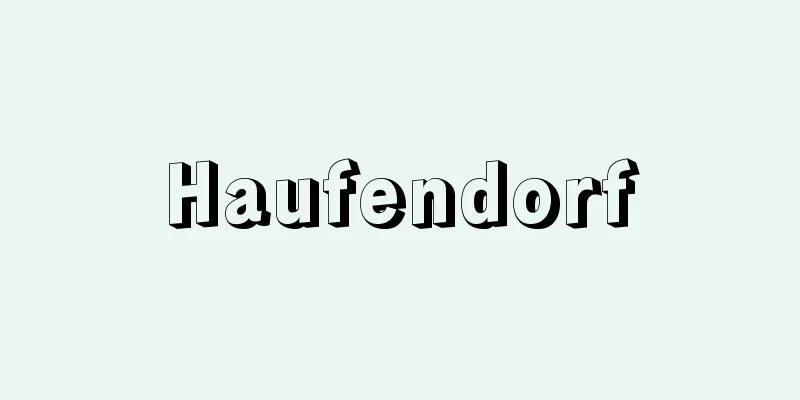Haufendorf

|
...When we consider the settlement forms of Europe based on various medieval documents and historical sources, as well as surviving farm maps created in the 17th and 18th centuries, we can see that there are broadly three types that have existed since the Middle Ages: One type is the "Haufendorf," a clustered village best suited to the three-field farming method, in which around 30 peasant houses, each with their own vegetable garden, are clustered together to form a core in the center of the village, surrounded by hedges or fences, with several communal cultivated areas outside of that, and common land such as forests, pastures, and wasteland.The second is a "small village" with a loose grouping of around 10 houses, common common land and cultivated areas, but also individual cultivated land scattered irregularly, a form known as a "Weiler" in Germanic regions and a "hamlet" in England.The third type is the "Einzeldorf," a scattered village in which each house has its own vegetable garden, blocks of cultivated land of various sizes, or pastures around the house, and the houses are scattered, with very loose collective regulations. In addition, there are other types such as the "Strassendorf" town or village, which has houses, vegetable gardens, cultivated land, and pastures regularly arranged along roads through reclamation or land reclamation, and the "Rundling, Runddorf" village, which is found in Slavic areas, but the above three can be considered the main settlement types in Western Europe. *Some of the terminology that mentions "Haufendorf" is listed below. Source | Heibonsha World Encyclopedia 2nd Edition | Information |
|
… ところで,中世における各種の文書史料ならびに17,18世紀に作製された残存の耕地図などにより,ヨーロッパの集落形態を考えてみると,それには大きく分けて次の三つのタイプが,中世以来存在していたことがわかる。すなわちその一つは,ほぼ30戸前後の農民家屋敷がおのおの自家の菜園地を伴いながら,〈むら〉の中心部に核をなして密集し,その周囲を垣根や柵で取り囲み,その外側にいくつかの共同耕区がひろがり,さらにその外側に森林,牧草地,荒蕪地などの入会地をもつという,三圃農法に最も適合的な〈集村Haufendorf〉であり,第2は10戸前後のルーズなまとまりで,共同の入会地や耕区もあるが,各戸別の耕地も不規則に散在する〈小村〉,すなわちゲルマン地域で〈ワイラーWeiler〉,イギリスで〈ハムレットhamlet〉などと呼ばれる形態であり,第3のタイプは,家屋敷の周囲に各戸の菜園地やブロック状の大小さまざまな耕地,あるいは牧草地などをもち,一戸一戸が分散して,団体規制のきわめてゆるい〈散村Einzeldorf〉である。このほか,干拓や開墾により計画的に道路に沿って規則正しく各戸の家屋敷,菜園地,耕地,牧草地などをもつ〈街村Strassendorf〉,あるいはスラブ系諸族の地域にみられる〈円村Rundling,Runddorf〉などのタイプがあるが,西ヨーロッパの主要な集落形態は,上述の三つと考えてよい。… ※「Haufendorf」について言及している用語解説の一部を掲載しています。 出典|株式会社平凡社世界大百科事典 第2版について | 情報 |
<<: Haupt und Staatsaktionen (English notation) Hauptund Staatsaktionen
Recommend
Blue-and-white flower - Blue-and-white flower
An evergreen shrub of the Plumageceae family (APG...
Russian and Soviet Art - Russian and Soviet Art
This article provides an overview of the character...
madina (English spelling)
…Even today, when new European-style towns have d...
Emanuel - Emmanuel
…In the pre-classical period, the sonatas of the ...
Ozeki clan
…A small outside domain with its headquarters in ...
Red Cucumber - Red Cucumber
…They are found all over Japan, digging U-shaped ...
Indian Theatre
There are various opinions about the origin of In...
Political corruption
Political corruption is created when public power...
Korzhinskii, DS (English spelling) KorzhinskiiDS
…For equilibrium to exist, c - p ≧0 must be satis...
Church law - ius ecclesiasticum (Latin)
This refers to the legal system that governs the ...
Letter of credit - Shinyojo (English spelling) letter of credit
A letter of guarantee in which the importer's...
The Earthly Paradise
A long narrative poem by the English poet and craf...
Kaminus - Kaminus
… [Hiroyuki Suzuki] [Western Chimneys] In Shakesp...
Haldane, John Burdon Sanderson
Born: November 5, 1892, Oxford [Died] December 1, ...
"Kashima standing god image"
...The above is the basic form, but in the late K...
![Heguri [town] - Heguri](/upload/images/67ccc79f4e506.webp)


![Takasaki [city] - Takasaki](/upload/images/67cc1ce8725f1.webp)





